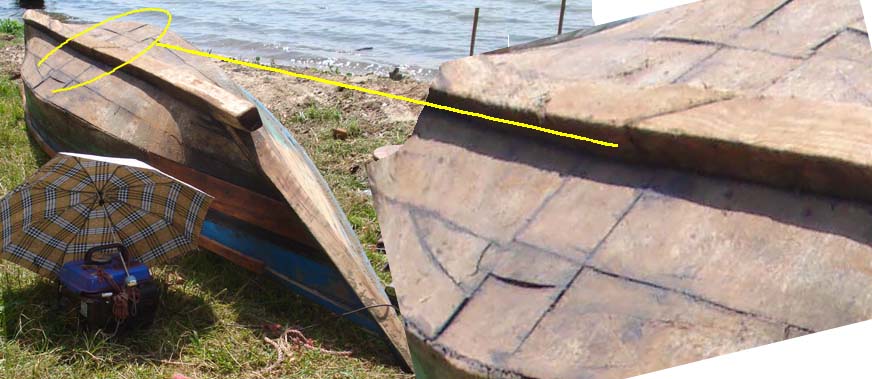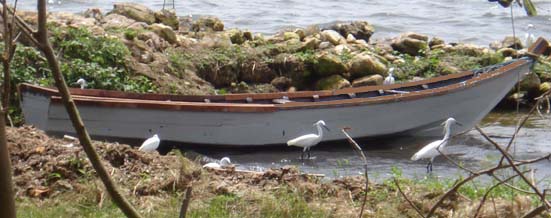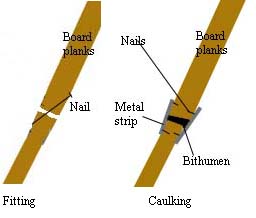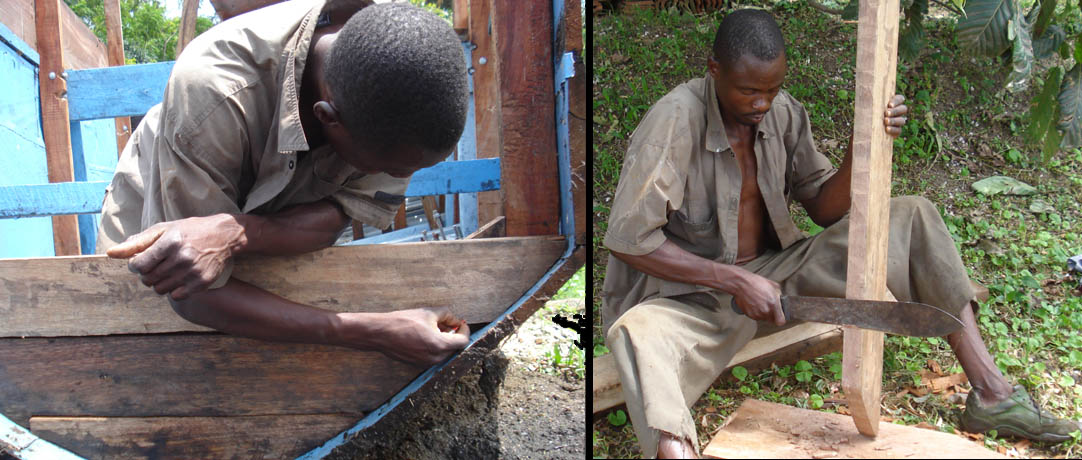
Crtd 09-01-18 Lastedit 15-10-27
How To Make A Bad Canoe
For The Same Money!
It looked nice enough to pay him for the work...
One year ago, on our Big Round around all shores of Lake Victoria, visiting the Tanzanian harbour town Mwanza, I took the opportunity to order a new mninga canoe. Ours was a worn out Uganda make (technical details below). I preferred a Mwanza canoe, because in Mwanza they have the best hardwood for boats, mninga, and the Arabs taught them many centuries ago to make a solid frame first and then mount boards by joining planks. Philemon knew a good canoe builder and spend part of his day going there and supervising. Just at the time it got finished, we got stalked by Mwanza police and, remembering the thoroughly nasty behaviour of Mwanza immigration and police when finishing the dhow, we decided to leave without delay. No time for a thorough check of our delivered product! Towing it North to Kenya it looked nice (photo). Since nothing could be claimed anymore, I refrained from a deep inspection of the canoe. Later on I saw some bad mounting, felt a vague dissatisfaction, but all in passing, my mind on other business. A year later the top of the port board disintegrated at the rear size, rotting. ROTTING?? This is supposed to be mninga! No, it was not. It was not even a hard wood. And, in fact had we not got stalked by police, our canoe should have had his product returned for working on it another two weeks,
Wood: 80% no mninga, even soft wood for boards, soft wood even patched, (but he had been careful enough to take some rubbish wood with a mninga-ish colour)
Mounting: He had never drilled before hammering his big nails. Wood split and broke. Nailing in the direction of the fibres of the wood.
Caulking: Bad caulking. The above water joints were not caulked at all
Painting: One highly diluted layer of paint, just enough to leave an impression of colour. No protection for water and wood boring lake insects
That left a record sum of of money in the thug's pocket. Now, after 13 months, we see this:




Patching a 13 months' old canoe

Sanding the canoe: generator needs umbrella to prevent
thermal fuse circuit break
Just look at the bottom patches. This was how he build it!

Amazingly good result: firm and dry

A wrong hose pipe for one of our
pumps, cut in half, made our canoe
fender strip.
Plants succeed holding on the bottom marine paint we laid over the epoxy. My
plan for next time: epoxy only. Its surface is literally hard as glass,
anything trying to hold is brushed off easily. With hard brush on a long
stick you do the dhow bottom every two months. No antifouling.
The Ultimate Technical Disaster: The Ugandan canoe
 Ugandans do not start
with frames. They fix two very thick board planks, at each side to a keel and a
bow beam, then fix another set of two board planks to ones already fixed. The
hull shape is formed by the fitting of the planks to each other, so the two
boards are usually far from symmetric. the board planks are joined like this:
Ugandans do not start
with frames. They fix two very thick board planks, at each side to a keel and a
bow beam, then fix another set of two board planks to ones already fixed. The
hull shape is formed by the fitting of the planks to each other, so the two
boards are usually far from symmetric. the board planks are joined like this:
To avoid a mess, board planks are cut very wide, so a fishing canoe will need two only at each side. Next, metal strips are nailed both sides over the joint, with bitumen in between, to close for water.
Finally thoughts are spent on stiffness and solidity. In many smaller canoes, like our previous Uganda make canoe, benches are thought to come in handy for the purpose. They are fitted by nailing in the direction of their fibres (!) from outside the board to inside. That is it! No need to say: a Ugandan canoe is a total loss within three years.
 The grey one: our previous canoe, Ugandan make
The grey one: our previous canoe, Ugandan make
The blue one: Dom's recently bought Ugandan disaster canoe. Same recipe: boards first. Solidity and stiffness requires more thoughts, which ends up like what you see right: a passenger bench and, on bottom and opposite board: what the Ugandan canoe has instead of frames. It must be said, Dom's trophy is a particularly humouristic specimen.

Philemon (see the brown wood behind him) mounted better hull frames, though in the Ugandan way - or else he should have dismounted the entire boat until the single planks it consists of. Then he cut the stern off entirely. Now he fits new hardwood sternbeams - using a panga!